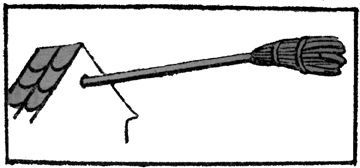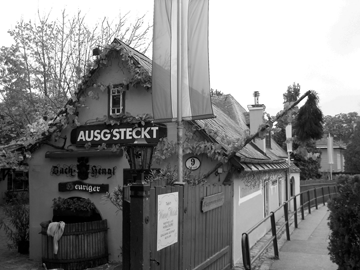While Lillywhite does not catalogue any tavern names beginning with Ivy, he records no fewer than seven taverns identified as The Bush in seventeenth century London, none of which, he remarks, are still to be found there today (1972). Though they attest the use of The Ivy Bush "Ivy Bush" as an inn/tavern name, Larwood and Hotten do not indicate any cities in which such an inn/tavern was to be found.
A pub named The Ivy Bush has stood on a corner of Hagley Road with Chad Road and Vicarage Road in Edgbaston since at least the 1880s.[8] It is only about a four-minute walk[9] from where the Tolkien family lived at 4 Highfield Road. The pub is so well known that its name is used for the intersection on which it stands.
Hindley calls the "sign of the bush" "without inscription, the oldest" inn/tavern sign, pointing to its origins as a Roman custom. (p. 90)[10] Lillywhite explains that the bush used for this purpose in England was ivy. (p. 86) Larwood and Hotten remark that many inns used ivy as their only sign as late as the reign of King James I (1603-1625). (p. 151)

Sign of the Bush
Delderfield notes that, while initially the "sign of the bush" was only used for establishments that served wine, it was later used in England to identify alehouses as well. Brand's Popular Antiquities of Great Britain makes this clear with an extensive selection of quotes and a proverb.[11] "The trade of the ivy-bush," explains Braithwaithe in his Laws of Drinking (1617), is that of running a public house. In his Wonderful Years (1603), Dekker glosses "a bush at the end of a pole" as "the ancient badge of a country alehouse." "Bacchus" is called "the sole sovereign of the Ivy-bush" in Braithwaithe's Strappado for the Divell(1615).
In the fourteenth century, the "marketing techniques" used by the keepers of roadside inns and ale houses were so aggressive that the poles used to suspend the bush advertising their wares stuck so far out into the street as to form a danger to passing riders, because, when astride their horses, the riders' heads were on the same level as the poles, and the two had a tendency to bump into one another. In 1375, this necessitated the passage of an act that limited the length of "bush" poles to seven feet.[12]
In Arthur Conan Doyle's The White Company (1891),[13] a book that Tolkien almost certainly read (C&G.816), Doyle's hero comes across a forest inn on the outskirts of Lyndhurst. As it is already dark there are "two flambeaux blazing on either side of the door as a welcome to the traveler. From one window there thrust forth a long pole with a bunch of greenery tied to the end of it—a sign that liquor was to be sold within." (p. 34) Later, the hero spies an inn near the village of Pitt's Deep, which is marked "with a great green bush hung upon a pole from one of the upper windows." (p. 360) The inn that Doyle's hero encounters in France, however, is marked "with a great bunch of holly hung out at the end of a stick from one of the upper windows." (p. 262)
In John Buchan's novel The Blanket of the Dark (1931),[14] a novel that Tolkien very probably read,[15] Buchan provides an interesting bit of alehouse lore that was not found in other sources. One of the scenes of the book plays in Gosford, a tiny hamlet on the Cherwell, north of Oxford, where the local drinking establishment is only known as "the alehouse." It was identified by a "bush at its door," but, at the time of the hero's arrival, the bush "was turned upside down—the innkeeper's sign that there was sickness in the hostelry and that no guests could be entertained." (p. 142)
The interchangeability of the terms ivy bush and bush is, perhaps, best demonstrated in the well-known proverb of "good wine needs no bush," which both Brand and the OED gloss to mean good wine needs no advertisement. The example in the OED is the short form, which comes from "The Epilogue" of Shakespeare's As You Like It (c. 1600): "If it be true that good wine need no bush, 't is true that a good play needs no epilogue." The example in Brand uses the long form. He quotes Greene in Concept (1598) by Dickenson: "Good wine needs no Ivie Bush."
In the time when literacy was not as widespread as it currently is in the industrialized English-speaking nations, the signs identifying taverns and inns were pictorial rather than written, because most of their customers were not likely to be able to read. Tolkien hints that the time frame of his story is that of a Shire when literacy was less than universal with the comment from Sam's father —clearly a regular at The Ivy Bush —that Bilbo taught Sam "his letters—meaning no harm mark you, and I hope no harm will come of it" (F.47). The senior Gamgee's comment suggests that he himself cannot read, and that he places no great value on the ability to do so.
The title of Chapter 9 of The Fellowship of the Ring likewise points to the time of pictorial signs for taverns and inns. It is "At the Sign of the Prancing Pony." "A large signboard" swung above the entrance to the inn. On it was painted "a fat white pony reared on its hind legs" (F.209). The words identifying the inn were not painted on the signboard, but "above the door" (F.209). The independent nature of sign and bush is demonstrated in a quote from the inn-keeper in Rowlands' Good News and Bad news (1622): "I rather will take down my bush and sign / Then live by means of riotous expense."[16] He had both an (ivy) bush and a sign to identify his establishment to his patrons. According to Lupton (1632), the display of a bush was sufficient to indicate the profession plied in the house, but if the house was "graced with a signe compleat, it's a signe of a good custome".[17] Using Lupton's criterion, The Prancing Pony was clearly a house of 'good custome.'
While The Ivy Bush may have had a signboard above the entrance, it is just as likely that it only had a real ivy bush hung above the door. The two Polish, the Czech, and one of the nine Russian (Nemirova) translators[18] envisioned Tolkien's inn as having a sign or emblem hung by the door. This can be seen in their translations of the name of the inn as "At the Sign of the Ivy Bush." I found this a more satisfying solution to this translation problem than simply calquing the name The Ivy Bush into the target language.
The lack of sources that attest the use of the name The Ivy Bush by a real inn/tavern (see above) suggests that The Ivy Bush was not the name of a real inn of Tolkien's acquaintance, but rather a classification of the type of inn, one identified by the showing of an ivy bush. Since Tolkien said that he liked history and considered its finest moments to be those that shed light on words and names (L.205), it is conceivable that Tolkien's linguistic imagination was prompted by the proverbial "good wine needs no ivy bush," and that he was replicating a version of the linguistic sleight of hand that he pulled with the name of the river that flowed past Bywater and Hobbiton. It was called The Water.[19] This is the same trick that Kenneth Grahame (1859–1932) pulled in The Wind in the Willows (1908). There, when Mole says "So—this—is—a—river?", Rat corrects him, informing him that it is "The River."[20] If the small inn on the road between Bywater and Hobbiton was the only inn around that displayed an ivy bush, it was The Ivy Bush, and since Tolkien's tale was one of great antiquity, The Ivy Bush on the Bywater road was, therefore, the precursor of the ivy bush in the proverb.
Many of the other translators of my acquaintance only made calques of the name The Ivy Bush. This is a satisfactory solution for translators who are not localizing the story by acclimating all the names to the local culture. Translators who are adapting the names to make the story seem more at home in the target language, however, will want to seek a solution that is the name of the emblem displayed above the doors of wine/ale houses in their culture.
In Austria, for example, the bush in question is a bundle of evergreen—not ivy—boughs, and the establishment is known as a Buschenschank (literally: a bush (adjective) place where things are poured).

A Buschenschank in Grinzing a suburb of Vienna
While the temptation to use Buschenschank for the German translation of The Ivy Bush is great, I would have resisted it, because the use of this name is much too localized. German readers would have been inclined to locate The Shire in eastern Austria, which is the natural habitat of the Buschenschank. A less localized alternative would be the word Reisigbusch, which is also used to identify the bundle of evergreen branches over the door of a Buschenschank. Both Carroux and Krege said Efeubusch (Ivy Bush)—a compound not attested in either the Brockhaus-Wahrig (1981) or in Grimm (1862), two well-known, reputable German defining dictionaries—but they localized the other Shire names, with translations like: Hobbingen "Hobbingen" (Hobbiton) and Herr Beutlin "Beutlin" von Beutelsend "Beutelsend" (Mr. Baggins from Bag-End).
End Notes:
[1] Eric R. Delderfield. Inns and Their Signs, London: David & Charles, 1975.
[2] Charles Hindley. Tavern Anecdotes and Sayings Including the Origins of Signs and Reminiscences Connected with Taverns, Coffee-houses, Clubs etc., London: Chatto and Windus, 1881.
[3] Richard Keverne. Tales of Old Inns, London: Collins, 1939.
[4] Bryant Lillywhite. London Signs: A Reference Book of London Signs from Earliest Times to About the Mid-nineteenth Century, London: George Allen & Unwin, 1972.
[5] B.W. Matz. Dickensian Inns and Taverns, NY: Charles Scribner's Sons, 1922.
[6] A.E. Richardson & H.D. Eberlein. The English Inn Past and Present, London: Benjamin Blom, 1968.
[7] Jacob Larwood & John Camden Hotten. English Inn Signs, London: Chatto and Windus, 1951.
[8] Terry Slater, Edgbaston: A History, Chichester, West Sussex: Phillimore & Co., 2002, p. 28.
[10] See also: Frederick W. Hackwood. Inns, Ales and Drinking Customs of Old England, NY: Sturgis and Walton, 1909, p. 297.
[11] Brand's Popular Antiquities of Great Britain (in two volumes, edited by W. Carew Hazlitt), London: Reeves and Turner, 1905, vol. 1, pp. 83-84. All the quotes that follow in this paragraph are from Brand.
[12] Alexander H. Japp, "Inns of the Middle Ages," in Atalanta: The Victorian Magazine, vol. III, October 1894 - September 1895, p. 697.
[13] Arthur Conan Doyle, The White Company, New York: Dodd, Mead and Company, 1927.
[14] John Buchan (1875-1940). The Blanket of the Dark, Boston and New York: Houghton Mifflin, 1931.
[15] See: Hooker, "Reading John Buchan in Search of J.R.R. Tolkien," forthcoming in The Bones of the Ox: Source-study and the Works of J.R.R. Tolkien, Jason Fisher, editor.
[16] Quoted in: Brand, vol. 1, p. 83, also in Larwood & Hotten, p. 152.
[17] Quoted in Larwood & Hotten, p. 152.
[18] For more on the Russian translations, see: Hooker, Tolkien Through Russian Eyes, Switzerland: Walking Tree Press, 2003.
[19] For a more detailed explanation of exactly what Tolkien did with the name The Water, see: Hooker, A Tolkienian Mathomium, 2006, pp. 65-68.
[20] Kenneth Grahame. The Wind in the Willows, NY: Charles Scribner's Sons, 1954, p. 9.
